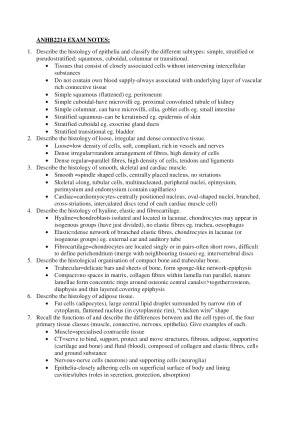ANHB2214 Exam Notes
Subject notes for UWA ANHB2214
Description
This is a concise version of the lecture notes answering the learning objectives, these notes were used for the written exam. The learning objectives answered are as follows: -the histology of epithelia and classify the different subtypes: simple, stratified or pseudostratified; squamous, cuboidal, columnar or transitional. -the histology of loose, irregular and dense connective tissue. -the histology of smooth, skeletal and cardiac muscle. -the histology of hyaline, elastic and fibrocartilage. -the histological organisation of compact bone and trabecular bone. -the histology of adipose tissue. -the functions of and describe the differences between and the cell types of, the four primary tissue classes (muscle, connective, nervous, epithelia) -the histology of the heart wall -the structure, arrangement and function of vessel walls -the differences between arteries/arterioles, veins/venules and lymphatic vessels. -the role of blood & lymphatic vessels in the circulatory system. -the role of each lymphoid organ (and its variable components) in the system. -key histological features of each lymphoid organ. and describe the cells of the respiratory epithelium. -Distinguish the difference between a bronchus, bronchiole, respiratory bronchiole, alveolar duct and alveolar sac. -the functions of type I and type II pneumocytes (alveolar cells). -the two separate blood supplies to the lungs and understand their functions. -the epithelial differences between the internal and external lip. -the muscles of the lip and tongue and recall the nerves that innervate them. -the types of tongue papillae and understand their differences. -the different compositions of the salivary glands and their parasympathetic innervation. -the changes in epithelium along the length of a salivon. -the four characteristic layers of the GIT throughout its length. -Understand how the mucosa, submucosa, muscularis externa of each organ of the GIT is specialised. -the functions of the liver, gallbladder and pancreas. -the dual blood supply of the liver. -how to differentiate the pancreas from a salivary gland. and describe the structural & functional specialisations of each gland. -the structural and functional relationship of the hypothalamus & the hypophysis. -the embryological development of the hypophysis and how it relates to the structure & function of the mature gland. -Understand the structure and important function of the hypothalamo-hypophyseal portal system. -Define and describe a nephron and a renal corpuscle. -Identify and understand the general functions of the macula densa, proximal convoluted tubule, nephron loop, vasa recta, distal convoluted tubule & collecting ducts. -the blood supply to the kidney, nephron. -the structure and function of the ureters, urinary bladder and urethra. -the gross structure of the testis. -between spermatogenesis and spermiogenesis. -the main functions of sustentocytes -the main functions of interstitial endocrine -the hormonal control of spermatogenesis. -the ducts involved in the passage of sperm. -the accessory sex glands and know their role. -structural features distinguishing the stages of follicular development -what occurs during the follicular phase and luteal phase of the ovarian cycle. -what occurs during the proliferative phase and secretory phase of the menstrual cycle. -the structure of the uterine tube, cervix and vagina, and non-lactating breast.
UWA
Semester 2, 2018
9 pages
3,658 words
$29.00
7
Campus
UWA, Crawley
Member since
February 2018
